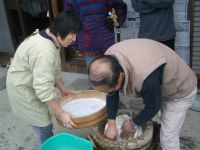Pounding Mochi
One of the traditional New Year's activities in Japan is making and eating mochi. Most people in the city no longer make mochi themselves, but I had the opportunity to visit my friend Tomo's home in the mountains of Gifu, about an hours train ride from Nagoya. Tomo does live painting in Tokyo and I have one of his beautiful paintings in my apartment in SF.
After warnings that we would have to start work on the mochi very early in the morning, we finally got started around 10 am. Actually, Ojiichan (grandfather) was outside steaming the rice before anyone else got involved. They use a special kind of mochi rice and steam it in a wood fired steamer until it's soft.

Ojiichan steaming rice the old fashioned way.
After the rice is ready it's transferred to a large stone bowl for pounding. At this point it's just rice, so you can't really pound it. The first step is to mush it up using a giant wooden hammer. Then you can pound it slowly until it turns into a paste, taking care not to hit it too hard and spray rice everywhere.
Pounding mochi is a two-person operation. One person pounds the mochi with a giant wooden hammer and the other one wets and repositions the mochi between each stroke. Obviously this requires some careful timing and lots of semi-meaningful grunts are employed for communication (un, yosh(i), etc...).
Both jobs are fairly difficult to get right. Without the exact right amount of water, the mochi gets too wet or too dry to pound correctly. And, needless to say, without the right timing things could get rather ugly rather quickly.
Since the head of the hammer is very long (approximately a foot and a half) it's very easy to twist the head of the hammer, producing a weak hit. The technique used is somewhat different from what you might expect from using a sledgehammer or similar sized smashing tool. In order to get a good stroke, you raise the hammer overhead and then pull with the lower hand, rather than pushing with the top hand. Once you get the hang of it, it works very well, although it's still a lot of work.

Me pounding mochi with my friend Tomo in the background in the blue shirt.
Although making mochi is certainly a whole-family affair, the master of ceremonies was definitely Tomo's father. He was involved in every aspect of the process, from pounding to drying to eventually cutting the mochi into squares for later use. Where he really shined, however, was in the pounding.
Seemingly tireless, you could definitely tell the difference between when he was pounding and one of us foreigners or city-slicker Japanese were trying our hand at it. When struck correctly, the mochi makes a satisfying "pok" sound that is difficult to describe, other than that it is the sound of a very large wooden hammer smashing solidly into a very squishy mass of rice paste. Of course, if you knew what that sounded like, you'd most likely know what pounding mochi sounds like.
After pounding, the mochi is transferred indoors where it is layed out in large wooden boards for drying.

Tomo's parents taking the mochi indoors.
After drying, the mochi is cut up into 2x3 inch squares for later use. Of course, a large part of the reason for making mochi during New Years is to eat it during the holiday. In the middle of making mochi, we took a break and rolled balls of mochi in various toppings, such as red bean paste, sweet peanut powder, and daikon and ginger.
The next day we enjoyed hot soup with a big sticky mass of mochi at the bottom. On the following, we grilled mochi squares over a kerosene heater, dipped them in soy sauce, melted cheese on them, and wrapped them in nori (seaweed). I think this was my favorite mochi, although the peanut mochi was delicious as well.
In the states, frozen mochi with ice cream inside is quite popular, and the Dim Sum restaurants in San Francisco seem to have invented a new dish. They use the traditional Dim Sum egg custard mix, wrap it in mochi, and then pan-fry it. It's delicious. I can't decide if it's better than the agedashi mochi (lightly breaded mochi with a sublte soy dipping sauce) that we often get after Japanese class at Tanpopo in Japan town.
However, mochi is not all fun and games. It's quite serious business in Japan. In fact, since it's sooo sticky some of the more aged indulgents wind up choking on it every year. Apparently the solution, however unpleasant, is to use a vacuum cleaner.
It's also a lot of work, even though there were 3 generations of Saitos there as well as 3 gaijin and another 4 or 5 Japanese friends. When it was all said and done, Tomo admitted that he had invited lots of friends over for New Year's at his house partially so that there wouldn't be quite as much work making mochi. I didn't mind, though. It was very nice to experience a more traditional way of life than I'm used to.
After warnings that we would have to start work on the mochi very early in the morning, we finally got started around 10 am. Actually, Ojiichan (grandfather) was outside steaming the rice before anyone else got involved. They use a special kind of mochi rice and steam it in a wood fired steamer until it's soft.

Ojiichan steaming rice the old fashioned way.
After the rice is ready it's transferred to a large stone bowl for pounding. At this point it's just rice, so you can't really pound it. The first step is to mush it up using a giant wooden hammer. Then you can pound it slowly until it turns into a paste, taking care not to hit it too hard and spray rice everywhere.
Pounding mochi is a two-person operation. One person pounds the mochi with a giant wooden hammer and the other one wets and repositions the mochi between each stroke. Obviously this requires some careful timing and lots of semi-meaningful grunts are employed for communication (un, yosh(i), etc...).
Both jobs are fairly difficult to get right. Without the exact right amount of water, the mochi gets too wet or too dry to pound correctly. And, needless to say, without the right timing things could get rather ugly rather quickly.
Since the head of the hammer is very long (approximately a foot and a half) it's very easy to twist the head of the hammer, producing a weak hit. The technique used is somewhat different from what you might expect from using a sledgehammer or similar sized smashing tool. In order to get a good stroke, you raise the hammer overhead and then pull with the lower hand, rather than pushing with the top hand. Once you get the hang of it, it works very well, although it's still a lot of work.

Me pounding mochi with my friend Tomo in the background in the blue shirt.
Although making mochi is certainly a whole-family affair, the master of ceremonies was definitely Tomo's father. He was involved in every aspect of the process, from pounding to drying to eventually cutting the mochi into squares for later use. Where he really shined, however, was in the pounding.
Seemingly tireless, you could definitely tell the difference between when he was pounding and one of us foreigners or city-slicker Japanese were trying our hand at it. When struck correctly, the mochi makes a satisfying "pok" sound that is difficult to describe, other than that it is the sound of a very large wooden hammer smashing solidly into a very squishy mass of rice paste. Of course, if you knew what that sounded like, you'd most likely know what pounding mochi sounds like.
After pounding, the mochi is transferred indoors where it is layed out in large wooden boards for drying.

Tomo's parents taking the mochi indoors.
After drying, the mochi is cut up into 2x3 inch squares for later use. Of course, a large part of the reason for making mochi during New Years is to eat it during the holiday. In the middle of making mochi, we took a break and rolled balls of mochi in various toppings, such as red bean paste, sweet peanut powder, and daikon and ginger.
The next day we enjoyed hot soup with a big sticky mass of mochi at the bottom. On the following, we grilled mochi squares over a kerosene heater, dipped them in soy sauce, melted cheese on them, and wrapped them in nori (seaweed). I think this was my favorite mochi, although the peanut mochi was delicious as well.
In the states, frozen mochi with ice cream inside is quite popular, and the Dim Sum restaurants in San Francisco seem to have invented a new dish. They use the traditional Dim Sum egg custard mix, wrap it in mochi, and then pan-fry it. It's delicious. I can't decide if it's better than the agedashi mochi (lightly breaded mochi with a sublte soy dipping sauce) that we often get after Japanese class at Tanpopo in Japan town.
However, mochi is not all fun and games. It's quite serious business in Japan. In fact, since it's sooo sticky some of the more aged indulgents wind up choking on it every year. Apparently the solution, however unpleasant, is to use a vacuum cleaner.
It's also a lot of work, even though there were 3 generations of Saitos there as well as 3 gaijin and another 4 or 5 Japanese friends. When it was all said and done, Tomo admitted that he had invited lots of friends over for New Year's at his house partially so that there wouldn't be quite as much work making mochi. I didn't mind, though. It was very nice to experience a more traditional way of life than I'm used to.


1 Comments:
I have video clip of some professionals making mochi in Nara - mazingly fast guys.
http://www.singlespeed.org/Blog/MakingMochi.MOV
Post a Comment
<< Home